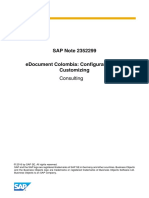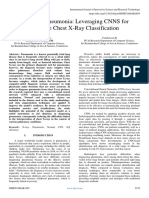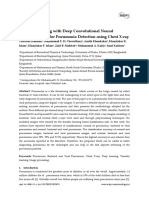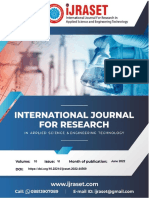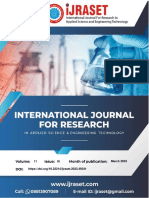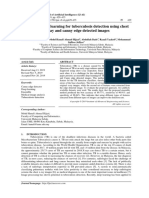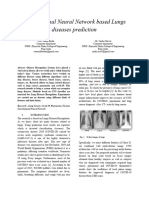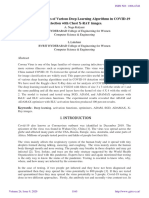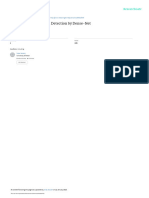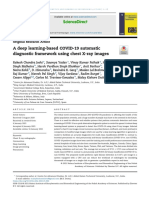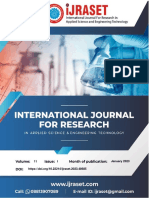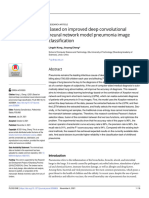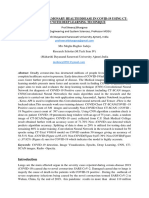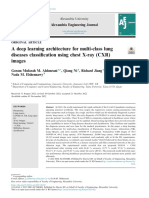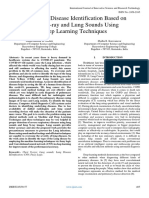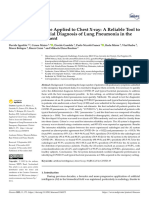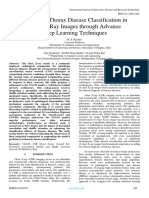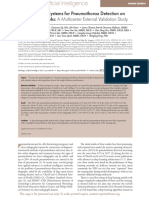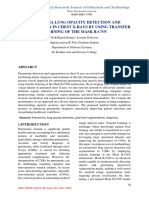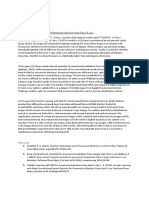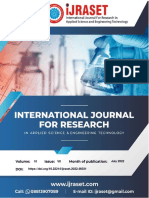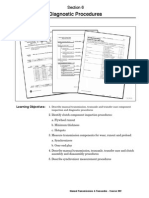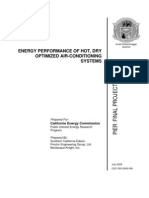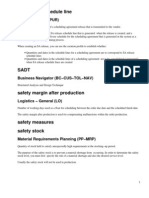Professional Documents
Culture Documents
Comparison of Deep Learning Algorithms For Pneumonia Detection
Original Title
Copyright
Available Formats
Share this document
Did you find this document useful?
Is this content inappropriate?
Report this DocumentCopyright:
Available Formats
Comparison of Deep Learning Algorithms For Pneumonia Detection
Copyright:
Available Formats
Volume 8, Issue 5, May – 2023 International Journal of Innovative Science and Research Technology
ISSN No:-2456-2165
Comparison of Deep Learning Algorithms for
Pneumonia Detection
Amrutha P M, Mariya Philip, Ashwaika P V
Department of Mathematics, Amrita School of Physical Science,
Amrita Vishwa Vidyapeetham, Kochi, Kerala, India
Abstract:- Pneumonia is a very dangerous disease that II. RELATED WORKS
affects the lungs of human beings and can even cause
death. It is caused by a bacteria called Streptococcus CheXNet: Radiologist-Level Pneumonia Detection on
pneumoniae. There are different types of pneumonia like Chest X-Rays with Deep Learning (2017)
bacterial, viral, and covid 19 pneumonia. This mainly Pranav Rajpurkar, Jeremy Irvin, et al. (2017)
affects children below five years and elderly people. developed an algorithm that could detect 4,444 types of
Chest X-rays are used to diagnose pneumonia and this pneumonia from chest X-rays at a level that far exceeds the
needs expert radiotherapists for evaluation. This may practice of radiology. The CheXNet algorithm is a 121-layer
cause a delay in detecting pneumonia which can be life- convolutional neural network trained on ChestX-ray14. Four
threatening. Here comes the need for deep learning practice radiologists described tests in which they compared
algorithms for analyzing medical images. In this paper, CheXNet’s performance to that of radiologists. They found
we use deep learning algorithms like CNN, transfer that the CheXNet outperformed the average radiologist’s F1
learning and ANN in detecting pneumonia and compare metric.
their accuracies to determine which algorithm is better.
Chest X-ray dataset from Guangzhou Women and Pneumonia detection using CNN-based feature ex-
Children’s Medical Center is used. traction(2019)
In the work of Dimpy Varshni; Kartik Thakral; Lucky
I. INTRODUCTION Agarwal; Rahul Ni-jawan; Ankush Mittal (2019),evaluated
the ability of pre-trained CNN models to be used as feature
A lung infection known as pneumonia is brought on by extractors and then used different classifiers for the clas-
bacteria, viruses, or fungi. The infection causes sification of abnormal and normal chest X-rays. To do this,
inflammation in the lungs’ alveoli, which are small air sacs. they determine the best CNN model through analysis. The
As the alveoli swell with liquid or pus, breathing becomes obtained results show that the proposed CNN model used in
challenging.[1]Pneumonia causes the death of around conjunction with the observer algorithm is much more
700,000 children every year and affects 7 percentage of the useful in the analysis of chest X-ray images, especially in
global population. In the present scenario where Covid19, the diagnosis of lung disease.
which was found as a cluster of pneumonia, is pertaining the
estimate of people affected by lung diseases is doubled. In Pneumonia detection in chest X-ray images using con-
the beginning, doctors used a clinical examination, a volutional neural networks and transfer learning(2020)
patient’s medical history, and chest X-rays to diagnose A paper by Rachna Jain, Preeti Nagrath et al (2020),
pneumonia. Different computer-aided diagnosis methods presents a convolutional neural network model for lung
can be used to solve the issue of a lack of experts. Deep cancer diagnosis using X-ray images. Several convolutional
learning is mostly used for pneumonia detection that occurs neural networks were trained to classify X-ray images into
more quickly. In order to determine which deep learning two classes, pneumonia and non-pneumonia, by varying the
algorithm provides higher accuracy at a faster rate, we are parameters, hyper-parameters, and number of layers. Six
analysing the accuracy of various deep learning algorithms models are mentioned in the article. The first and second
in this study. The compared algorithms include CNN, ANN, models have two and three convolution layers, respectively.
and transfer learning. Each year, pneumonia affects over 450 The other four models are pre-trained models which are
million people worldwide. The majority of children under 5 VGG16, VGG19, ResNet50, Inception-v3.
who develop pneumonia. This age group of kids has the
highest prevalence of pneumonia-related deaths. Among the Prediction of Community-Acquired Pneumonia Using
models compared and studied, CNN was found to have Artificial Neural Networks(2003)
higher accuracy than other models. Paul S.Heckerling, MD, Ben S.Gerber et al wrote a
paper in which ANN was trained on health, symptoms,
signs, symptoms, and recommendation data from 1044
patients at the University of Illinois (training group) and
applied to 116 patients at the University of Nebraska.
patients (test cohort). ANNs trained with different strategies
were compared among themselves and the main effects were
IJISRT23MAY733 www.ijisrt.com 1511
Volume 8, Issue 5, May – 2023 International Journal of Innovative Science and Research Technology
ISSN No:-2456-2165
compared with logistic regression. Calibration accuracy was disease tests. Experimental results show the possibility of
measured as the square of the error and discrimination training deep learning models on published data on chest X-
accuracy was measured as the area under the receiver ray images to diagnose lung diseases. The efficacy of chest
operating characteristic (ROC) curve. X-rays of COVID-19 patients has been confirmed by a
special diagnostic model.
A Novel COVID-19 Diagnosis Support System Using the
Stacking Approach and Transfer Learning Technique on III. METHODOLOGY
Chest X-Ray Images (2021)
Soufiane Hamida et al. wrote an article in 2021 in a Dataset description
similar domain. The purpose of this article is to improve the The dataset has three folders: train, test, and valuation,
rapid and accurate diagnosis of COVID-19 on chest X-ray with a subfolder for each type of image
images by using the stacking technique combined with (pneumonia/normal). 5,863 X-ray images (JPEG) are
transfer learning and KNN algorithm to select the best included, with 2 classifications (pneumonia/normal). At the
model. This approach can store and use the knowledge Guangzhou Women and Children’s Medical Centre, chest
gained by pre-trained convolutional neural networks to X-ray images (anterior-posterior view) were chosen from a
solve new problems. To ensure the robustness of the retrospective cohort of paediatric patients between the ages
proposed system for diagnosing COVID-19 patients using of one and five. The patient receives routine clinical care
X-ray images, we use a machine learning technique called that includes all chest X-rays. Prior to analysis, all chest
stacking to combine the performances of the many transfer radiographs were checked for quality control to exclude any
learning based models. The model was trained on data that subpar or unlawful scans. In order to train the AI system, the
included four categories such as COVID-19, tuberculosis, diagnostics from the photos were first cleaned up and scored
pneumonia, and common diseases. Validation data was by two experienced doctors. A third expert also checked the
collected from a 6-domain dataset of X-ray images. They evaluation set to rule out any scoring problems.
use different general measures to evaluate the effectiveness
of the proposal. The proposed method achieved a very high Process
accuracy of 99.23 The process consists of four stages,
Selection of appropriate dataset
Pneumonia Detection Using Deep Learning Based on Data preprocessing
Convolutional Neural Network(2021) Building the model
Luka Raˇci´c; Tomo Popovi´c; Stevan ˇcaki´c; Stevan Prediction based on the accuracy of deep learning
Sandi together did their research using deep learning based algorithms
on cnn in 2021 itself. Their article describes the use of
machine learning algorithms to process chest X-ray images Data Pre-processing
to support decision making. In particular, the research We first alter our photographs to make them better
focuses on the development of models using deep learning candidates for training a convolutional neural network
algorithms based on neural networks. The role of the model before we begin. Then we do data preprocessing and data
is to help solve the classification problem of detecting augmentation for this assignment using the Keras Image
whether the chest X-ray varies according to the lung disease Data Generator function. Additionally, this class provides
and dividing the X-ray images into two groups according to simple data enhancements like random image horizontal
the diagnosis. flipping. Additionally, we utilise the generator to change
each batch’s values to have a mean of 0 and a standard
Deep Learning on Chest X-ray Images to Detect and deviation of 1. By normalising the input distribution, this
Evaluate Pneumonia Cases at the Era of COVID- will facilitate model training. The generator additionally
19(2021) changes our grayscale x-ray images to a three-channel
As COVID-19 hit, faster detection of pneumonia format by iterating over the image’s values across all
became more necessary. During that period, Karim channels. We need to do this since the pre-trained model we
Hammoudi , Halim Benhabiles wrote a paper regarding this. will be using demands that the images be in a three-channel
Because lung diseases can be detected by X-rays, this article format.
explores the deep learning process for the evaluation and
interrogation of chest X-rays, hoping to provide patient Algorithms Used
doctors with equipment that has been tested for and Here the dataset is split into train, test, and validation
identifies patients for COVID-19. In this context, training datasets. In this study, we use deep learning algorithms like
datasets, deep learning and analysis techniques from the ANN, CNN, and transfer learning. Trans-fer learning makes
data contained in chest X-ray images were tested. There is a use of different algorithms like DenseNet, VGG16, ResNet,
different learning process from the learning model to learn and InceptionNet. We use these algorithms for detecting
about pneumonia, especially infectious diseases. It is pneumonia. In this paper, we compare these algorithms and
assumed that cases of pneumonia diagnosed in the context find out which one is more accurate for prediction.
of the spread of COVID-19 disease are most likely to be
considered a disease of COVID-19 disease. In addition,
simple sanitation measures have been proposed to predict
the spread of disease and predict patient status from lung
IJISRT23MAY733 www.ijisrt.com 1512
Volume 8, Issue 5, May – 2023 International Journal of Innovative Science and Research Technology
ISSN No:-2456-2165
Deep Learning where the dataset is small, transfer learning may be helpful.
A subset of machine learning called ”deep learning” The idea behind transfer learning is straightforward: we take
uses neural networks. It may discover intricate links and a big data learning model and apply its expertise to small
patterns in the data. It is founded on deep neural networks data. We freeze the network’s initial convolutional layers for
(DNN), often referred to as artificial neural networks object recognition in CNN and train the final few layers just
(ANN). These neural networks are built to learn from for prediction. [10]tTransfer learning has recently been
massive amounts of data, and they were inspired by the applied successfully in a variety of real-world settings,
architecture and operation of organic neurons found in the including manufacturing, healthcare, and baggage screening.
human brain. An input layer is coupled to one or more This eliminates the need for a sizable dataset and shortens
primitive layers in a fully connected deep neural network. the lengthy training period that the deep learning system
The previous group of neurons fed information to each requires when created from scratch.
neuron. Up until the formation of the final layer of the
network, the output of one neuron becomes the input of To solve the vanishing/exploding gradient problem, the
additional neurons in the subsequent layer. The layers of the architecture intro-duces a concept called residual blocks. In
neural network transform the input data with non-linear this network, we use a technique called skip-connections.
transformations, allowing the network to learn the Skip-connection links the processes of one layer to other
representation of the input data. layers by skipping some layers. This creates a residual
block. Resnet is created by putting the residual block
CNN Architecture together. The benefit of adding this kind of skip-connections
CNNs have gained popularity as a result of their is that if a layer causes any problem in architectural
enhanced picture categorization capabilities. The network’s operation it will be skipped by the normal process. The
convolutional layers and filters aid in the extraction of an network uses a 34-layer traditional network architecture
image’s spatial and temporal information. The weight- inspired by VGG-19 and then adds short links. These short
sharing method used by the layers aids in minimising links then converts the architecture to the residual network.
computational work. CNNs are the best choice for tasks like
image classification, object identification, and im-age Each layer in DenseNet is linked to every other layer
segmentation because they can learn the characteristics of deeper in the network.[11]Compared to a conventional
images. The input layer, convolutional layer, pooling layer, CNN, the DenseNet design requires less parameters. Only
and fully connected layers are only a few of the layers that 12 filters and a limited number of new feature maps are used
make up a convolutional neural network. in DenseNet layers. With some essential differences, it is
extremely similar to a ResNet. Due to the disappearing
A set of filters (or kernels) with modest widths and the gradients generated by the distance between input and
same height and depth as the volume make up the output processes, where data is lost before it reaches its
convolutional process. Each stride (for high-resolution destination, DenseNet was particularly created to improve
images, its value can be 2, 3, or even 4) represents the accuracy in advanced neural networks.[11]By providing
amount of time it takes to gradually move each filter across access to the gradient values from the loss function and the
the entire volume as we compute the dot product between input image, DenseNet resolves this problem. In a DenseNet
the kernel weights and patch from the input volume. When with L layers, there will be approximately L and L plus one
we move the filters, the output is filled with filters of the by two connections, or L(L+1)/2. So in dense networks we
same depth because we combined the 2D outputs of each have less layers than other models, so here we can easily
filter. All the filters will be learned by the network. train models with more than 100 layers using this method.
This layer is placed in CNN from time to time and its One of the most well-known models of convolutional
main function is to reduce the size of the volume, thus neural network (CNN) architecture to date is VGG16. It
speeding up computation, reducing memory and preventing begins with blocks of two or three convolutional layers, then
overfitting. The two types of pooling layers are max pooling moves on to a pooling layer, a dense network made up of
and average pooling. If we use 2 x 2 filters and max pooling two hidden layers, and finally an output layer. VGG16
with stride 2, the resulting volume will be 16x16x12. The employs a max pooling layer with a 2x2 filter with stride 2
results of the maps are flattened into one-dimensional and a convolutional layer with a 3x3 filter at the same
vectors after the convolution and pooling layers so that they padding in place of several hyperparameters. Throughout
can be transmitted to a fully connected layer for the architecture, it always adheres to the convolutional and
classification or regression. maximum pooling layer orders. Last but not least, it has two
arrays of connections, all of which are output by Softmax.
The results of the combined process are then put into a The 16 in VGG16 denotes the presence of 16 weighted
logistic function for classification, such as sigmoid or layers.
softmax, which transforms the output of each class into a
probability score test for all classes. The GoogleNet is another name for the InceptionNet.
The architecture offers inception module subnets. It enables
Transfer learning quick training, complicated pattern computation, and
A larger dataset often yields better results for CNNs parameter usage optimisation. To increase speed and
than a smaller one does. When using CNN in applications precision, it employs a variety of strategies. There are 22
IJISRT23MAY733 www.ijisrt.com 1513
Volume 8, Issue 5, May – 2023 International Journal of Innovative Science and Research Technology
ISSN No:-2456-2165
layers in the architecture altogether. Nine linearly fitted
inception modules make up GoogleNet. There are 22 layers
(27 including the outer layers). The architecture’s last layer,
global average pooling, which determines the average value
of each feature map, replaces all previous levels. This
drastically lowers the total number of parameters.
ANN Architecture
Artificial neural networks are created from the
structures and operations of human neurons. It is also called
neural network. Artificial neurons, also called units, are Fig 1: Accuracy Graph
found in artificial neural networks. All the artificial nueral
networks made up of these artificial neurons are arranged in The work under discussion assesses how well different
a single layer. A fully connected neural network has an input deep learning algorithms, such as ANN, CNN and transfer
layer and one or more hidden layers. Each neuron receives learning, such as DenseNet, ResNet,VGG16 and
input from the previous input processes. The output of one InceptionNet, recognise pneumonia. We evaluate the
neuron becomes the input of other neurons in the next layer performance of various algorithms to see which one is faster
of the network, and this process continues until the last layer and more accurate. The best deep learning-based pneumonia
of the network is formed. Then, after going through one or detection algorithm must be selected based on the results of
more hidden processes, this information is converted into this test. DenseNet surpassed other methods utilised in the
master information for the output process. Finally, the study, according to the computed accuracy of 93 percentage.
output process is displayed as the neural network’s response The DenseNet model per-formed this task with great
to the incoming data. accuracy, raising the possibility that it could help identify
pneumonia early even in the absence of specialised
IV. RESULT radiologists.
The death rate from pneumonia can be lowered with V. CONCLUSION
early identification. various algorithms is effective in
identifying pneumonia. Our goal was to identify the Detection of pneumonia in its early stage is necessary
algorithm that serves superior. In order to do that, we to reduce the death rate. Due to the lack of expert
contrasted a number ofdeep learning algorithms, including radiotherapists, this task becomes a bit difficult, this is
ANN, CNN, and transfer learning. Accuracy ratings for the solved using deep learning algorithms. In our study, we have
models were determined. The fraction of correctly predicted used several algorithms to detect pneumonia and concluded
outcomes is what is referred to as accuracy. that DenseNet is more accurate than other algorithms in the
faster detection of pneumonia with a calculated accuracy of
The accuracy is measured using different elements 93 percentage.
namely true positives(P), true negatives(N), false
positives(p), false negatives(n),precision(x) and recall(y). It REFERENCES
is calculated using the below equation:
[1]. Mohammad Farukh Hashmi, Satyarth Katiyar, Avinash
Accuracy = (P + N)/(P + N + p + n) (1) G Keskar, Neeraj Dhanraj Bokde, and Zong Woo
Geem. Efficient pneumonia detec-tion in chest xray
The recall score for a model is calculated as: images using deep transfer learning. Diagnostics
(Basel), 10(6), June 2020.
Recall = y = P/(P + n) (2) [2]. Pranav Rajpurkar, Jeremy Irvin, Kaylie Zhu, Brandon
Yang, Hershel Mehta, Tony Duan, Daisy Ding, Aarti
Precision is defined as the number of accurate positive Bagul, Curtis Langlotz, Katie Sh-panskaya, Matthew P
predictions and is calcu-lated as: Lungren, and Andrew Y Ng. CheXNet: Radiologist-
Level pneumonia detection on chest X-Rays with deep
P recision = x = P/(P + p) (3) learning. arXiv [cs.CV], November 2017.
[3]. Dimpy Varshni, Kartik Thakral, Lucky Agarwal, Rahul
F1-score measures the model’s accuracy and it is calculated Nijhawan, and Ankush Mittal. Pneumonia detection
as: using CNN based feature extrac-tion. In 2019 IEEE
International Conference on Electrical, Computer and
F 1Score = (2 ∗ x ∗ y)/(x ∗ y) (4) Communication Technologies (ICECCT), pages 1–7,
February 2019.
[4]. Rachna Jain, Preeti Nagrath, Gaurav Kataria, V Sirish
Kaushik, and D Jude Hemanth. Pneumonia detection in
chest x-ray images using convo-lutional neural
networks and transfer learning. Measurement,
165:108046, December 2020.
IJISRT23MAY733 www.ijisrt.com 1514
Volume 8, Issue 5, May – 2023 International Journal of Innovative Science and Research Technology
ISSN No:-2456-2165
[5]. Paul S Heckerling, Ben S Gerber, Thomas G Tape, and
Robert S Wig-ton. Prediction of community-acquired
pneumonia using artificial neural networks. Med.
Decis. Making, 23(2):112–121, 2003.
[6]. Soufiane Hamida, Oussama El Gannour, Bouchaib
Cherradi, Abdelhadi Raihani, Hicham Moujahid, and
Hassan Ouajji. A novel COVID-19 di-agnosis support
system using the stacking approach and transfer
learning technique on chest X-Ray images. J. Healthc.
Eng., 2021:9437538, Novem-ber 2021.
[7]. Luka Raˇci´c, Tomo Popovi´c, Stevan Caki´c, and
Stevan Sandi. Pneumonia detection using deep
learning based on convolutional neural network. In
2021 25th International Conference on Information
Technology (IT), pages 1–4, February 2021.
[8]. Karim Hammoudi, Halim Benhabiles, Mahmoud
Melkemi, Fadi Dornaika, Ignacio Arganda-Carreras,
Dominique Collard, and Arnaud Scherpereel. Deep
learning on chest x-ray images to detect and evaluate
pneumonia cases at the era of COVID-19. J. Med.
Syst., 45(7):75, June 2021.
[9]. Daniel S Kermany, Michael Goldbaum, Wenjia Cai,
Carolina C S Valentim, Huiying Liang, Sally L Baxter,
Alex McKeown, Ge Yang, Xiaokang Wu, Fangbing
Yan, Justin Dong, Made K Prasadha, Jacqueline Pei,
Magdalene Y L Ting, Jie Zhu, Christina Li, Sierra
Hewett, Jason Dong, Ian Ziyar, Alexander Shi, Runze
Zhang, Lianghong Zheng, Rui Hou, William Shi, Xin
Fu, Yaou Duan, Viet A N Huu, Cindy Wen, Edward D
Zhang, Charlotte L Zhang, Oulan Li, Xiaobo Wang,
Michael A Singer, Xiaodong Sun, Jie Xu, Ali Tafreshi,
M Anthony Lewis, Huimin Xia, and Kang Zhang.
Identifying medical diagnoses and treatable diseases by
Image-Based deep learning. Cell, 172(5):1122–
1131.e9, February 2018.
[10]. Tawsifur Rahman, Muhammad E H Chowdhury, Amith
Khandakar, Khan-daker R Islam, Khandaker F Islam,
Zaid B Mahbub, Muhammad A Kadir, and Saad
Kashem. Transfer learning with deep convolutional
neural net-work (CNN) for pneumonia detection using
chest x-ray. NATO Adv. Sci. Inst. Ser. E Appl. Sci.,
10(9):3233, May 2020.
[11]. Vikash Chouhan, Sanjay Kumar Singh, Aditya
Khamparia, Deepak Gupta, Prayag Tiwari, Catarina
Moreira, Robertas Damaˇseviˇcius, and Victor Hugo C
de Albuquerque. A novel transfer learning based
approach for pneumonia detection in chest x-ray
images. NATO Adv. Sci. Inst. Ser. E Appl. Sci.,
10(2):559, January 2020.
IJISRT23MAY733 www.ijisrt.com 1515
You might also like
- Mental Health Awareness and PFA Training ReportDocument4 pagesMental Health Awareness and PFA Training ReportSHEILA MAE PERTIMOS100% (14)
- CustomizingDocument5 pagesCustomizingEduardo Padilla Lozano100% (1)
- Prediction of Pneumonia Using CNNDocument9 pagesPrediction of Pneumonia Using CNNIJRASETPublicationsNo ratings yet
- 1 s2.0 S0957417422016372 MainDocument14 pages1 s2.0 S0957417422016372 MainMd NahiduzzamanNo ratings yet
- SirishKaushik2020 Chapter PneumoniaDetectionUsingConvoluDocument14 pagesSirishKaushik2020 Chapter PneumoniaDetectionUsingConvoluMatiqul IslamNo ratings yet
- Decoding Pneumonia: Leveraging CNNS for Accurate Chest X-Ray ClassificationDocument7 pagesDecoding Pneumonia: Leveraging CNNS for Accurate Chest X-Ray ClassificationInternational Journal of Innovative Science and Research TechnologyNo ratings yet
- Covid-19 Pneumonia Classification Using Deep Learning TechniqueDocument20 pagesCovid-19 Pneumonia Classification Using Deep Learning TechniqueJilly Arasu100% (1)
- Ies50839 2020 9231540Document5 pagesIes50839 2020 9231540AhdiatShinigamiNo ratings yet
- Pneumonia Detection Using Convolutional Neural Networks (CNNS)Document14 pagesPneumonia Detection Using Convolutional Neural Networks (CNNS)shekhar1405No ratings yet
- 2004 06578 PDFDocument19 pages2004 06578 PDFSumaNo ratings yet
- A Survey Paper On Pneumonia Detection in Chest X-Ray Images Using An Ensemble of Deep LearningDocument9 pagesA Survey Paper On Pneumonia Detection in Chest X-Ray Images Using An Ensemble of Deep LearningIJRASETPublicationsNo ratings yet
- Chest X Ray Detection Project ReportDocument45 pagesChest X Ray Detection Project ReportNikhil Sharma100% (1)
- Identifying Pneumonia in Chest X-Rays Using Deep LearningDocument8 pagesIdentifying Pneumonia in Chest X-Rays Using Deep LearningDiego Alejandro Betancourt PradaNo ratings yet
- Pneumonia Disease Detection Using Deep LearningDocument6 pagesPneumonia Disease Detection Using Deep LearningIJRASETPublicationsNo ratings yet
- Ensemble Deep Learning For Tuberculosis Detection Using Chest X-Ray and Canny Edge Detected ImagesDocument7 pagesEnsemble Deep Learning For Tuberculosis Detection Using Chest X-Ray and Canny Edge Detected ImagesIAES IJAINo ratings yet
- Convolutional Neural Network Based Lungs Diseases PredictionDocument3 pagesConvolutional Neural Network Based Lungs Diseases Predictionshirsat.deep18No ratings yet
- Deep neural network ensemble for pneumonia localizationDocument12 pagesDeep neural network ensemble for pneumonia localizationAmílcar CáceresNo ratings yet
- Identifying Pulmonary Nodules or Masses On Chest Radiography Using Deep Learning: External Validation and Strategies To Improve Clinical PracticeDocument8 pagesIdentifying Pulmonary Nodules or Masses On Chest Radiography Using Deep Learning: External Validation and Strategies To Improve Clinical PracticeYuriansyah Dwi Rahma PutraNo ratings yet
- COVID-19 Diagnosis Using Deep CNN Model on Chest X-Ray ImagesDocument18 pagesCOVID-19 Diagnosis Using Deep CNN Model on Chest X-Ray ImagesAISHWARYA PANDITNo ratings yet
- Performance Analysis of Various Deep Learning Algorithms in COVID-19 Detection With Chest X-RAY ImagesDocument8 pagesPerformance Analysis of Various Deep Learning Algorithms in COVID-19 Detection With Chest X-RAY Imageslaxmi.slvNo ratings yet
- Paper_2021__1Document5 pagesPaper_2021__1स्वराज कुमारNo ratings yet
- A Deep Learning-Based COVID-19 Automatic Diagnostic Framework Using Chest X-Ray ImagesDocument16 pagesA Deep Learning-Based COVID-19 Automatic Diagnostic Framework Using Chest X-Ray ImagesEshaNo ratings yet
- Comparative Analysis of Deep Learning Convolutional Neural Networks Based On Transfer Learning For Pneumonia DetectionDocument12 pagesComparative Analysis of Deep Learning Convolutional Neural Networks Based On Transfer Learning For Pneumonia DetectionIJRASETPublicationsNo ratings yet
- (IJCST-V11I2P5) :Dr.S.Selvakani, K.Vasumathi, M.GopiDocument5 pages(IJCST-V11I2P5) :Dr.S.Selvakani, K.Vasumathi, M.GopiEighthSenseGroupNo ratings yet
- matterDocument40 pagesmattervemaladileep77599No ratings yet
- NN 2Document18 pagesNN 2Lastri Widya ANo ratings yet
- Deep Learning Approach For Unprecedented Lung Disease PrognosisDocument5 pagesDeep Learning Approach For Unprecedented Lung Disease PrognosisMulla Abdul FaheemNo ratings yet
- Seminar Report Final Year CT ScanDocument13 pagesSeminar Report Final Year CT ScanKapil SidhpuriaNo ratings yet
- Automated Diagnosis of COVID-19 With Limited PosteDocument17 pagesAutomated Diagnosis of COVID-19 With Limited PosteYULIANo ratings yet
- Chest X-Ray Outlier Detection Using Dimension Reduction and Edge DetectionDocument11 pagesChest X-Ray Outlier Detection Using Dimension Reduction and Edge DetectionHardik AgrawalNo ratings yet
- Pneumonia and COVID-19 Detection Using Convolutional Neural NetworkDocument10 pagesPneumonia and COVID-19 Detection Using Convolutional Neural NetworkIJRASETPublicationsNo ratings yet
- A Deep Learning Architecture For Multi-Class LungDocument13 pagesA Deep Learning Architecture For Multi-Class LungAbhishek TripathiNo ratings yet
- An Efficient CNN Model For COVID-19 Disease DetectDocument12 pagesAn Efficient CNN Model For COVID-19 Disease Detectnasywa rahmatullailyNo ratings yet
- Pneumonia Detection Using Deep Learning MethodsDocument7 pagesPneumonia Detection Using Deep Learning MethodsIJRASETPublicationsNo ratings yet
- Radiol 221894Document10 pagesRadiol 221894JEFFERSON MUÑOZNo ratings yet
- (IJCST-V9I3P10:Akshat Rustagi, Rudrangshu Tarafder, J. Rene BeulahDocument7 pages(IJCST-V9I3P10:Akshat Rustagi, Rudrangshu Tarafder, J. Rene BeulahEighthSenseGroupNo ratings yet
- Document3 TexDocument4 pagesDocument3 TexNavin M ANo ratings yet
- Research Article Review On Diagnosis of COVID-19 From Chest CT Images Using Artificial IntelligenceDocument10 pagesResearch Article Review On Diagnosis of COVID-19 From Chest CT Images Using Artificial IntelligenceKurama Nine TailsNo ratings yet
- Anapub Paper TemplateDocument10 pagesAnapub Paper Templatebdhiyanu87No ratings yet
- Pulmonary Disease Identification Based On Chest X-Ray and Lung Sounds Using Deep Learning TechniquesDocument7 pagesPulmonary Disease Identification Based On Chest X-Ray and Lung Sounds Using Deep Learning TechniquesInternational Journal of Innovative Science and Research TechnologyNo ratings yet
- Efficient Lung Infection Detection Using Machine Learning ApproachDocument9 pagesEfficient Lung Infection Detection Using Machine Learning ApproachIJRASETPublicationsNo ratings yet
- Covi-Assist Automatic COVID-19 Detection From Chest X-RaysDocument10 pagesCovi-Assist Automatic COVID-19 Detection From Chest X-RaysIJRASETPublicationsNo ratings yet
- Deep Learning For Automatic Pneumonia DetectionDocument8 pagesDeep Learning For Automatic Pneumonia Detectionnessus joshua aragonés salazarNo ratings yet
- Applied Sciences: A Novel Transfer Learning Based Approach For Pneumonia Detection in Chest X-Ray ImagesDocument17 pagesApplied Sciences: A Novel Transfer Learning Based Approach For Pneumonia Detection in Chest X-Ray ImagesmzshaikhNo ratings yet
- Diagnostic Use of Lung Ultrasound Compared To Chest Radiograph For Suspected Pneumonia in A Resource-Limited SettingDocument5 pagesDiagnostic Use of Lung Ultrasound Compared To Chest Radiograph For Suspected Pneumonia in A Resource-Limited SettingGhaisani Nur ShabrinaNo ratings yet
- Artificial Intelligence Applied to Chest Xray a Reliable Tool to Assess the Differential Diagnosis of Lung Pneumonia in the Emergency DepartmentDiseasesDocument13 pagesArtificial Intelligence Applied to Chest Xray a Reliable Tool to Assess the Differential Diagnosis of Lung Pneumonia in the Emergency DepartmentDiseasesoualid-kunNo ratings yet
- Application of Deep Learning Techniques For Detection of COVID-19 Casesusing Chest X-Ray Images A Comprehensive StudyDocument12 pagesApplication of Deep Learning Techniques For Detection of COVID-19 Casesusing Chest X-Ray Images A Comprehensive StudyHarshini N BNo ratings yet
- Pneumonia Detection Using Deep LearningDocument17 pagesPneumonia Detection Using Deep LearningAkashNo ratings yet
- MainDocument12 pagesMainnasywa rahmatullailyNo ratings yet
- Enhancing Thorax Disease Classification in Chest X-Ray Images Through Advance Deep Learning TechniquesDocument10 pagesEnhancing Thorax Disease Classification in Chest X-Ray Images Through Advance Deep Learning TechniquesInternational Journal of Innovative Science and Research TechnologyNo ratings yet
- A Neuro-Heuristic Approach For Recognition of Lung Diseases From X-RayDocument15 pagesA Neuro-Heuristic Approach For Recognition of Lung Diseases From X-RaySarah NixonNo ratings yet
- AI Breast ScreeningDocument2 pagesAI Breast ScreeningChan Chee HouNo ratings yet
- Diagnosis of Pneumonia From Chest X-Ray Images Using Deep LearningDocument5 pagesDiagnosis of Pneumonia From Chest X-Ray Images Using Deep LearningShoumik MuhtasimNo ratings yet
- Iaa CovisDocument8 pagesIaa Covissanya eusebia lupaca lupacaNo ratings yet
- Ryai 2021200190Document10 pagesRyai 2021200190Imagenologia Hospital de ClinicasNo ratings yet
- Lung Tumor Localization and Visualization in ChestDocument17 pagesLung Tumor Localization and Visualization in ChestAida Fitriyane HamdaniNo ratings yet
- PNEUMONIA LUNG OPACITY DETECTION AND SEGMENTATION IN CHEST X-RAYS BY USING TRANSFER LEARNING OF THE MASK R-CNNDocument9 pagesPNEUMONIA LUNG OPACITY DETECTION AND SEGMENTATION IN CHEST X-RAYS BY USING TRANSFER LEARNING OF THE MASK R-CNNWeb ResearchNo ratings yet
- AP20110010028 (Preview)Document1 pageAP20110010028 (Preview)Sameer Thadimarri AP20110010028No ratings yet
- Research Article An Improved Covid-19 Detection Using Gan-Based Data Augmentation and Novel Qunet-Based ClassificationDocument9 pagesResearch Article An Improved Covid-19 Detection Using Gan-Based Data Augmentation and Novel Qunet-Based ClassificationNaoual NassiriNo ratings yet
- Proceedings of Spie: Transfer Learning Methods For Classification of COVID-19 Chest X-Ray ImagesDocument8 pagesProceedings of Spie: Transfer Learning Methods For Classification of COVID-19 Chest X-Ray ImagesAriba Yusuf TubaNo ratings yet
- Pneumonia Detection in X-Ray Chest Images Based On CNN and Data AugmentationDocument18 pagesPneumonia Detection in X-Ray Chest Images Based On CNN and Data AugmentationIJRASETPublicationsNo ratings yet
- An Analysis on Mental Health Issues among IndividualsDocument6 pagesAn Analysis on Mental Health Issues among IndividualsInternational Journal of Innovative Science and Research TechnologyNo ratings yet
- Harnessing Open Innovation for Translating Global Languages into Indian LanuagesDocument7 pagesHarnessing Open Innovation for Translating Global Languages into Indian LanuagesInternational Journal of Innovative Science and Research TechnologyNo ratings yet
- Diabetic Retinopathy Stage Detection Using CNN and Inception V3Document9 pagesDiabetic Retinopathy Stage Detection Using CNN and Inception V3International Journal of Innovative Science and Research TechnologyNo ratings yet
- Investigating Factors Influencing Employee Absenteeism: A Case Study of Secondary Schools in MuscatDocument16 pagesInvestigating Factors Influencing Employee Absenteeism: A Case Study of Secondary Schools in MuscatInternational Journal of Innovative Science and Research TechnologyNo ratings yet
- Exploring the Molecular Docking Interactions between the Polyherbal Formulation Ibadhychooranam and Human Aldose Reductase Enzyme as a Novel Approach for Investigating its Potential Efficacy in Management of CataractDocument7 pagesExploring the Molecular Docking Interactions between the Polyherbal Formulation Ibadhychooranam and Human Aldose Reductase Enzyme as a Novel Approach for Investigating its Potential Efficacy in Management of CataractInternational Journal of Innovative Science and Research TechnologyNo ratings yet
- The Making of Object Recognition Eyeglasses for the Visually Impaired using Image AIDocument6 pagesThe Making of Object Recognition Eyeglasses for the Visually Impaired using Image AIInternational Journal of Innovative Science and Research TechnologyNo ratings yet
- The Relationship between Teacher Reflective Practice and Students Engagement in the Public Elementary SchoolDocument31 pagesThe Relationship between Teacher Reflective Practice and Students Engagement in the Public Elementary SchoolInternational Journal of Innovative Science and Research TechnologyNo ratings yet
- Dense Wavelength Division Multiplexing (DWDM) in IT Networks: A Leap Beyond Synchronous Digital Hierarchy (SDH)Document2 pagesDense Wavelength Division Multiplexing (DWDM) in IT Networks: A Leap Beyond Synchronous Digital Hierarchy (SDH)International Journal of Innovative Science and Research TechnologyNo ratings yet
- Comparatively Design and Analyze Elevated Rectangular Water Reservoir with and without Bracing for Different Stagging HeightDocument4 pagesComparatively Design and Analyze Elevated Rectangular Water Reservoir with and without Bracing for Different Stagging HeightInternational Journal of Innovative Science and Research TechnologyNo ratings yet
- The Impact of Digital Marketing Dimensions on Customer SatisfactionDocument6 pagesThe Impact of Digital Marketing Dimensions on Customer SatisfactionInternational Journal of Innovative Science and Research TechnologyNo ratings yet
- Electro-Optics Properties of Intact Cocoa Beans based on Near Infrared TechnologyDocument7 pagesElectro-Optics Properties of Intact Cocoa Beans based on Near Infrared TechnologyInternational Journal of Innovative Science and Research TechnologyNo ratings yet
- Formulation and Evaluation of Poly Herbal Body ScrubDocument6 pagesFormulation and Evaluation of Poly Herbal Body ScrubInternational Journal of Innovative Science and Research TechnologyNo ratings yet
- Advancing Healthcare Predictions: Harnessing Machine Learning for Accurate Health Index PrognosisDocument8 pagesAdvancing Healthcare Predictions: Harnessing Machine Learning for Accurate Health Index PrognosisInternational Journal of Innovative Science and Research TechnologyNo ratings yet
- The Utilization of Date Palm (Phoenix dactylifera) Leaf Fiber as a Main Component in Making an Improvised Water FilterDocument11 pagesThe Utilization of Date Palm (Phoenix dactylifera) Leaf Fiber as a Main Component in Making an Improvised Water FilterInternational Journal of Innovative Science and Research TechnologyNo ratings yet
- Cyberbullying: Legal and Ethical Implications, Challenges and Opportunities for Policy DevelopmentDocument7 pagesCyberbullying: Legal and Ethical Implications, Challenges and Opportunities for Policy DevelopmentInternational Journal of Innovative Science and Research TechnologyNo ratings yet
- Auto Encoder Driven Hybrid Pipelines for Image Deblurring using NAFNETDocument6 pagesAuto Encoder Driven Hybrid Pipelines for Image Deblurring using NAFNETInternational Journal of Innovative Science and Research TechnologyNo ratings yet
- Terracing as an Old-Style Scheme of Soil Water Preservation in Djingliya-Mandara Mountains- CameroonDocument14 pagesTerracing as an Old-Style Scheme of Soil Water Preservation in Djingliya-Mandara Mountains- CameroonInternational Journal of Innovative Science and Research TechnologyNo ratings yet
- A Survey of the Plastic Waste used in Paving BlocksDocument4 pagesA Survey of the Plastic Waste used in Paving BlocksInternational Journal of Innovative Science and Research TechnologyNo ratings yet
- Hepatic Portovenous Gas in a Young MaleDocument2 pagesHepatic Portovenous Gas in a Young MaleInternational Journal of Innovative Science and Research TechnologyNo ratings yet
- Design, Development and Evaluation of Methi-Shikakai Herbal ShampooDocument8 pagesDesign, Development and Evaluation of Methi-Shikakai Herbal ShampooInternational Journal of Innovative Science and Research Technology100% (3)
- Explorning the Role of Machine Learning in Enhancing Cloud SecurityDocument5 pagesExplorning the Role of Machine Learning in Enhancing Cloud SecurityInternational Journal of Innovative Science and Research TechnologyNo ratings yet
- A Review: Pink Eye Outbreak in IndiaDocument3 pagesA Review: Pink Eye Outbreak in IndiaInternational Journal of Innovative Science and Research TechnologyNo ratings yet
- Automatic Power Factor ControllerDocument4 pagesAutomatic Power Factor ControllerInternational Journal of Innovative Science and Research TechnologyNo ratings yet
- Review of Biomechanics in Footwear Design and Development: An Exploration of Key Concepts and InnovationsDocument5 pagesReview of Biomechanics in Footwear Design and Development: An Exploration of Key Concepts and InnovationsInternational Journal of Innovative Science and Research TechnologyNo ratings yet
- Mobile Distractions among Adolescents: Impact on Learning in the Aftermath of COVID-19 in IndiaDocument2 pagesMobile Distractions among Adolescents: Impact on Learning in the Aftermath of COVID-19 in IndiaInternational Journal of Innovative Science and Research TechnologyNo ratings yet
- Studying the Situation and Proposing Some Basic Solutions to Improve Psychological Harmony Between Managerial Staff and Students of Medical Universities in Hanoi AreaDocument5 pagesStudying the Situation and Proposing Some Basic Solutions to Improve Psychological Harmony Between Managerial Staff and Students of Medical Universities in Hanoi AreaInternational Journal of Innovative Science and Research TechnologyNo ratings yet
- Navigating Digitalization: AHP Insights for SMEs' Strategic TransformationDocument11 pagesNavigating Digitalization: AHP Insights for SMEs' Strategic TransformationInternational Journal of Innovative Science and Research Technology100% (1)
- Drug Dosage Control System Using Reinforcement LearningDocument8 pagesDrug Dosage Control System Using Reinforcement LearningInternational Journal of Innovative Science and Research TechnologyNo ratings yet
- The Effect of Time Variables as Predictors of Senior Secondary School Students' Mathematical Performance Department of Mathematics Education Freetown PolytechnicDocument7 pagesThe Effect of Time Variables as Predictors of Senior Secondary School Students' Mathematical Performance Department of Mathematics Education Freetown PolytechnicInternational Journal of Innovative Science and Research TechnologyNo ratings yet
- Formation of New Technology in Automated Highway System in Peripheral HighwayDocument6 pagesFormation of New Technology in Automated Highway System in Peripheral HighwayInternational Journal of Innovative Science and Research TechnologyNo ratings yet
- Section 6 - Diagnostic ProceduresDocument13 pagesSection 6 - Diagnostic Proceduresanon_152488453100% (1)
- TM Journal Class 5 Pharma Trademarks 2018Document1,192 pagesTM Journal Class 5 Pharma Trademarks 2018Tahir LabbeNo ratings yet
- Energy Performance of Hot, DryDocument128 pagesEnergy Performance of Hot, DrySrinu ReddyNo ratings yet
- Nanotechnology in TextilesDocument4 pagesNanotechnology in Textileskevin cagud PhillipNo ratings yet
- Parenteral Fluid Therapy: Types of Intravenous SolutionDocument18 pagesParenteral Fluid Therapy: Types of Intravenous SolutionKathleen Joy Costales Magtanong100% (1)
- Galloway 1989 Genetic Stratigraphic Sequence Basin Analysis IDocument18 pagesGalloway 1989 Genetic Stratigraphic Sequence Basin Analysis IMitreNo ratings yet
- BS 0812-114 - 1989Document12 pagesBS 0812-114 - 1989عمر عمرNo ratings yet
- JuliadatascienceDocument214 pagesJuliadatascienceFulvio JoséNo ratings yet
- Farmakoterapi Penyakit Infeksi: in Infectious Diseases Dewi Rahmawati, M.Farm-Klin.,AptDocument87 pagesFarmakoterapi Penyakit Infeksi: in Infectious Diseases Dewi Rahmawati, M.Farm-Klin.,AptYemima MNo ratings yet
- Unofficial Fanbook Made With Permission - Incar-NationDocument24 pagesUnofficial Fanbook Made With Permission - Incar-NationBrockPetersdorf-Nelson100% (1)
- AJPMenu Bar MCQDocument8 pagesAJPMenu Bar MCQAkNo ratings yet
- Orienteering Lesson PlanDocument34 pagesOrienteering Lesson PlanJuan Carlos Guillen BayonNo ratings yet
- 65-1-3-D MathematicsDocument8 pages65-1-3-D MathematicsRohan YadavNo ratings yet
- Acc Gr11 May 2009 PaperDocument13 pagesAcc Gr11 May 2009 PaperSam ChristieNo ratings yet
- Class of 2016 Graduate ListsDocument16 pagesClass of 2016 Graduate ListscallertimesNo ratings yet
- Kindergarten Quarter 4 Standards For Lesson PlansDocument2 pagesKindergarten Quarter 4 Standards For Lesson PlansLydiaDietschNo ratings yet
- 202-Nido 2024Document27 pages202-Nido 2024tabhonor69No ratings yet
- MTA powerVAL Technical Data Sheet v00Document1 pageMTA powerVAL Technical Data Sheet v00muhammetNo ratings yet
- Solar/Wind/Diesel Hybrid Energy System With Battery Storage For Rural ElectrificationDocument15 pagesSolar/Wind/Diesel Hybrid Energy System With Battery Storage For Rural ElectrificationWelde AynaleNo ratings yet
- Sap GlossaryDocument324 pagesSap GlossaryNikos TataliasNo ratings yet
- Global Detection - Electronic and Electromechanical Sensors Catalogue 2006.10 PDFDocument800 pagesGlobal Detection - Electronic and Electromechanical Sensors Catalogue 2006.10 PDFSarah RichardNo ratings yet
- Negros IslandDocument18 pagesNegros IslandGrace AmaganNo ratings yet
- Cucs 016 13 PDFDocument16 pagesCucs 016 13 PDFAnonymous SlyvspdBNo ratings yet
- Nitrogen CycleDocument15 pagesNitrogen CycleKenji AlbellarNo ratings yet
- Rocha Et Al 2020 Fostering Inter - and Transdisciplinarity in Discipline-Oriented Universities To Improve Sustainability Science and PracticeDocument12 pagesRocha Et Al 2020 Fostering Inter - and Transdisciplinarity in Discipline-Oriented Universities To Improve Sustainability Science and PracticeAna CarolinaNo ratings yet
- A Review of Air Filter TestDocument14 pagesA Review of Air Filter Testhussain mominNo ratings yet
- Rhythm MP - The Music Page - Theory Made Easy For Little Children Level 1Document9 pagesRhythm MP - The Music Page - Theory Made Easy For Little Children Level 1AmilacicNo ratings yet
- ResearchDocument44 pagesResearchGwend MemoracionNo ratings yet

